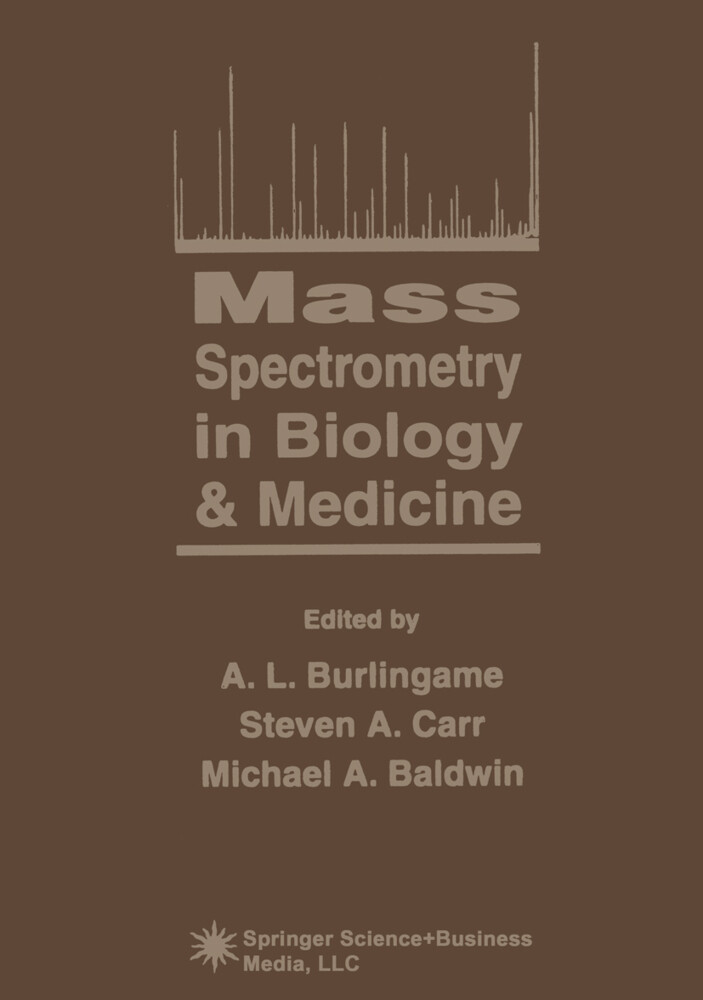
Zustellung: Mo, 20.01. - Mi, 22.01.
Versand in 2 Tagen
VersandkostenfreiBestellen & in Filiale abholen:
Leading practitioners detail revolutionary new spectrometric techniques for the identification and covalent structural characterization of macromolecules, proteins, glycoconjugates, and nucleic acids. Based on the Fourth International Symposium on Mass Spectrometry in the Health and Life Sciences held in San Francisco in 1998, this invaluable book contains tested strategies for solving many significant biomedical research problems. The techniques use mass spectrometry, automated computer processing of spectral information, and gene, protein, and EST databases for genomic and proteomic correlations. Mass Spectrometry in Biology and Medicine offers a unique opportunity to explore and apply these new techniques of mass spectrometry that are revolutionizing the identification and structural characterization of proteins, carbohydrates, and nucleic acids.
Inhaltsverzeichnis
A New Delayed Extraction MALDI-TOF MS-MS for Characterization of Protein Digests. - Measurements of Protein Structure and Noncovalent Interactions by Time-of-Flight Mass Spectrometry With Orthogonal Ion Injection. - Isotopic Amplification, H/D Exchange, and Other Mass Spectrometric Strategies for Characterization of Biomacromolecular Topology and Binding Sites. - Probing the Nature of Amyloidogenic Proteins by Mass Spectrometry. - Studying Noncovalent Small Molecule Interactions with Protein and RNA Targets by Mass Spectrometry. - Identification of Protein-Protein Interfaces by Amide Proton Exchange Coupled to MALDI-TOF Mass Spectrometry. - Electron Capture Dissociation Produces Many More Protein Backbone Cleavages Than Collisional and IR Excitation. - Protein Micro-Characterization by Mass Spectrometry: Sample Handling and Data Flow. - Towards an Integrated Analytical Technology for the Generation of Multidimensional Protein Expression Maps. - Sequencing the Primordial Soup. - Coaxial Nanospray Coupled with a Hybrid Quadrupole/Time-of-Flight Tandem Mass Spectrometer for Proteome Studies. - Life Without Databases: De Novo Sequencing of Small Gene Products and Complete Characterization of Posttranslational Modifications. - Investigation of Intact Subunit Polypeptide Composition of the 20S Proteasome Complex from Rat Liver Using Mass Spectrometry. - Deciphering Functionally Important Multiprotein Complexes by Mass Spectrometry. - Investigation of Apoptosis-Involved Processes by Mass Spectrometric Identification of the Apoptosis-Associated Proteins in IgM-Induced Burkitt Lymphoma Cells. - IR-MALDI Softer Ionization in MALDI-MS for Studies of Labile Macromolecules. - Identification of in-vivo Phosphorylation Sites with Mass Spectrometry. - Determination of Enzyme Mechanisms byStopped-Flow Electrospray Mass Spectrometry. - Glycosylation of Proteins A Major Challenge in Mass Spectrometry and Proteomics. - Site-specific Characterization of the N-linked Glycans of Murine PrPsc Using Advanced Methods of Electrospray Mass Spectrometry. - Matrix-Assisted Laser Desorption/Ionization Mass Spectrometry of N-Linked Carbohydrates and Related Compounds. - Electrophoretic and Mass Spectrometric Strategies for the Identification of Lipopolysaccharides and Immunodeterminants in Pathogenic Strains of Haemophilus influenzae; Application to Clinical Isolates. - Mycobacterial Lipoglycans: Structure and Roles in Mycobacterial Immunity. - The Impact of Drug Metabolism in Contemporary Drug Discovery: New Opportunities and Challenges for Mass Spectrometry. - Electrospray Mass Spectrometric Analysis of Lipid Mediators Derived from Arachidonic Containing Membrane Phospholipids. - Mass Spectrometry After the Human Genome Project. - Problems and Prospects in the Characterization of Posttranscriptional Modifications in Large RNAs. - Author Index.
Produktdetails
Erscheinungsdatum
26. Juli 2012
Sprache
englisch
Auflage
Softcover reprint of the original 1st ed. 2000
Seitenanzahl
592
Herausgegeben von
Michael A. Baldwin, A. L. Burlingame, Steven A. Carr
Verlag/Hersteller
Produktart
kartoniert
Abbildungen
XIV, 577 p. 324 illus.
Gewicht
1098 g
Größe (L/B/H)
254/178/32 mm
Sonstiges
Paperback
ISBN
9781468498295
Entdecken Sie mehr
Pressestimmen
" . . . of significant reference value. . . "
-Journal of the American Society of Mass Spectrometry
" . . . a valuable addition to the library of anyone working in the area of biomolecule characterization by mass spectrometry. "
-The Analyst
" . . . the writing and explanation are first rate. . . "
-Trends in Analytical Chemistry
" The purpose is to provide an overview of mass spectrometry. This worthy objective has been met. . . In 27 chapters the editors provide a very useful overview of the application of mass spectrometric methods to a wide variety of biological problems. " -Doody' s Health Sciences Book Review Journal
In 27 chapters the editors provide a very useful overview of the application of mass spectrometric methods to a wide vaiety of biological problems. Examples include determination of purity, molecular weight, presence of posttranslational modifications (glycosylation, phosphorylation), ligand binding, sequencing of peptides, coupling of purification protocols (capillary electrophoresis, for example) and the use of tandem spectrometers. -Doody' s Health Sciences Book Review Journal
-Journal of the American Society of Mass Spectrometry
" . . . a valuable addition to the library of anyone working in the area of biomolecule characterization by mass spectrometry. "
-The Analyst
" . . . the writing and explanation are first rate. . . "
-Trends in Analytical Chemistry
" The purpose is to provide an overview of mass spectrometry. This worthy objective has been met. . . In 27 chapters the editors provide a very useful overview of the application of mass spectrometric methods to a wide variety of biological problems. " -Doody' s Health Sciences Book Review Journal
In 27 chapters the editors provide a very useful overview of the application of mass spectrometric methods to a wide vaiety of biological problems. Examples include determination of purity, molecular weight, presence of posttranslational modifications (glycosylation, phosphorylation), ligand binding, sequencing of peptides, coupling of purification protocols (capillary electrophoresis, for example) and the use of tandem spectrometers. -Doody' s Health Sciences Book Review Journal
Bewertungen
0 Bewertungen
Es wurden noch keine Bewertungen abgegeben. Schreiben Sie die erste Bewertung zu "Mass Spectrometry in Biology & Medicine" und helfen Sie damit anderen bei der Kaufentscheidung.










